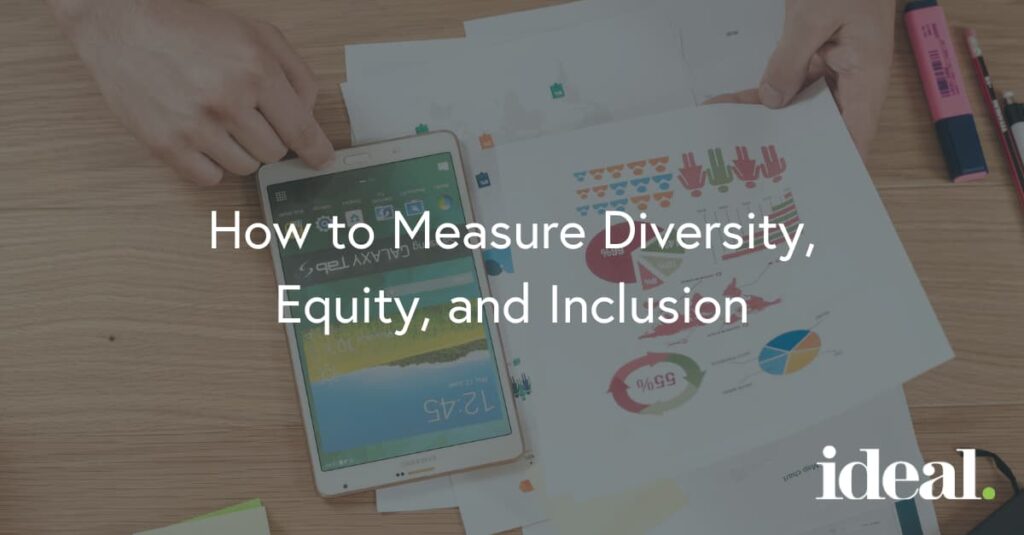
This past year brought about tremendous change in corporate America. Alongside so much tumult and tribulation came a renewed focus on measuring diversity, equity, and inclusion (DEI). A recent Forbes report, for example, found that 56% of the companies surveyed strongly agree that diversity helps drive innovation. Our own research shows that 50% of organizations now prioritize DEI. As welcome as this swell of support around DEI might be, the work really has just begun.

DEI is much more than a simple revision to a company’s mission statement, or public statements made by an executive on LinkedIn. Those gestures, however useful, must be accompanied by a plan for launching and measuring specific DEI initiatives. Unfortunately, only 7 percent of companies set representation targets for gender and race, according to a report from Lean In.
As it turns out, there is still a widespread lack of clarity around which key performance indicators (KPIs) make the most sense for measuring DEI. As such, we’ve put together a guide outlining the three core ways that organizations can begin to measure their diversity, equity, and inclusion.
1. Establish responsibility and accountability for DEI
A lack of awareness around responsibility and accountability is one of the fastest ways to torpedo a DEI initiative. It starts with getting buy-in at the executive level. That might mean assigning a top executive to lead and sponsor DEI programs, or establishing an entirely new executive DEI role. As part of these responsibilities, this executive might:
- Codify behavioral standards for holding organizational stakeholders accountable for results.
- Launch DEI training for people at all levels of the organization.
- Make an action plan for recruitment, performance management, leadership assessment, and training.
- Establish autonomous employee networks to further support these initiatives, such as resource groups and outreach committees.
- Identify DEI award programs for the company to pursue.
- Build a system for DEI performance monitoring, including regular reporting on specific goals and initiatives.
- Hold the leaders responsible for DEI accountable through performance reviews, bonuses, promotions, and other methods.
2. Establish baselines for recruitment, representation, and retention
We’re not talking about setting quotas. What we’re talking about is taking things a step back to take the pulse of your recruitment and employee retention efforts today. For example:
- What is the gender or ethnic breakdown of candidates for jobs you’ve hired for in the past six to twelve months?
- How are various groups represented at the executive and management levels of your organization?
- Are certain employee demographics more likely to leave your company than others?
Establishing a data pipeline around these and other metrics, then reporting on them regularly, can reveal trends and other insights that can help ensure that your recruitment, hiring, and on-the-job practices are equitable—and that they align with broader DEI objectives.
3. Keep tabs on productivity, morale, and turnover
Most likely, your organization is already reporting on productivity, morale, and turnover.
For productivity, you might examine hours worked, overtime, or absenteeism. Productivity metrics can get quite granular per department. The customer support team, for example, is likely keeping track of case close rates, wait times, and abandon rate.
You might measure morale through periodic employee reviews, surveys, and exit interviews. Turnover, finally, can be measured by squaring departures and redundancies against the total number of employees over a given period of time.
Yet, there are insights embedded within each of these metrics that can be quite useful to DEI stakeholders. Are certain groups struggling to meet productivity quotas? Does another group tend to leave within six months at a faster rate than others? Digging into these metrics and answering the “why” can lead to improvements that not only improve metrics overall, but equip DEI stakeholders with the data-backed arguments they need to make a business case to the leadership team.
Publish results for the whole world to see
One thing we regularly recommend is to create an externally visible scorecard to measure diversity, equity, and inclusion initiatives through their progress and performance. The same principle applies at the organizational level. Given the resurgence in interest around DEI, many organizations are publishing well-produced, publicly accessible annual reports around the status and success of their own DEI programs. Here are a few examples:
- Facebook Diversity Report: This annually released report collates updates from Facebook’s various diversity initiatives. This includes updates about financial support for supplier diversity and small businesses, as well as breakdowns of gender and ethnic representation at various levels of employment.
- citi Diversity Annual Report: Published online since 1999, this PDF report includes updated pay gap data, a breakdown of regional employee networks, and global workforce representation.
- Apple Inclusion & Diversity: While this report presents updated data around representation and equal pay, just like the other reports, it also brings in personal stories from various Apple employees throughout the organization.
Why measure DEI and publish results?
Measuring diversity, equity, and inclusion, then regularly reporting on results is important for a few reasons. First and foremost, it brings legitimacy and business interest to DEI. Often, a lack of awareness at the executive level, or the absence of performance data, can put DEI initiatives first in line for the chopping block. What happens then to the people and programs these initiatives stand to benefit?
By “making the business case” for DEI in the ways outlined above, you can demonstrate to both internal and external teams—current and prospective employees, partners, and customers—that your organization is committed to constantly evolving in the area of DEI.
For more ideas around expanding and strengthening your own DEI program, check out some of our DEI-focused posts: